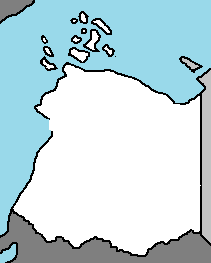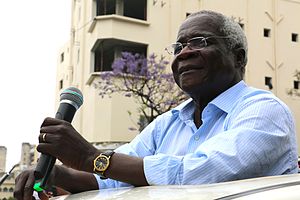Peoratia: Difference between revisions
No edit summary |
No edit summary |
||
| Line 120: | Line 120: | ||
==History== | ==History== | ||
===Prehistory=== | ===Prehistory=== | ||
[[wikipedia:Afar language|Afar]]-speaking people's migration into Peoratia dates as far back as the 4th century BC. It's believed between the 1st and 5th centuries AD, waves of migration from the west and north went through the Bembize River valley and then gradually into the plateau and coastal areas of Southern Adula. They established agricultural communities or societies based on herding cattle. They brought with them the technology for melting and smithing iron. | |||
===Middle Ages=== | ===Middle Ages=== | ||
From the late first millennium AD, vast [[Albarine Sea]] trade networks extended as far south into Peoratia as evidenced by the ancient port town of [[Thibuene]]. Beginning in the 9th century, a growing involvement in trade led to the development of numerous port towns along the entire coast, including modern day Peoratia. Largely autonomous, these towns broadly participated in the incipient Oromo culture. Islam was often adopted by urban elites, facilitating trade. In Peoratia, the Peoran tribe established itself as an empire by the 15th century and brought wide unity to the nation. | |||
===Modern Day=== | ===Modern Day=== | ||
====Albarinean occupation (1938-41)==== | ====Albarinean occupation (1938-41)==== | ||
[[Albarine]]an forces occupied Peoratia in 1938, two years after neighboring [[Buckingla]] was also occupied. As communist and anti-colonial ideologies spread out across Adula, many clandestine political movements were established in support of Peoratian independence. These movements claimed that since policies and development plans were primarily designed by the ruling authorities for the benefit of Peoratia's Albarinean population, little attention was paid to Peoratia's tribal integration and the development of its native communities. In 1941, Albarine withdrew due to a domestic economic depression and granted autonomy. | [[Albarine]]an forces occupied Peoratia in 1938, two years after neighboring [[Buckingla]] was also occupied. The 500-year old Peoran empire collapsed as a result. As communist and anti-colonial ideologies spread out across Adula, many clandestine political movements were established in support of Peoratian independence. These movements claimed that since policies and development plans were primarily designed by the ruling authorities for the benefit of Peoratia's Albarinean population, little attention was paid to Peoratia's tribal integration and the development of its native communities. In 1941, Albarine withdrew due to a domestic economic depression and granted autonomy. | ||
====Independence==== | ====Independence==== | ||
Revision as of 01:49, 15 August 2021
Democratic Republic of Peoratia Peoratia | |
|---|---|
|
Flag | |
 | |
| Capital | Syhazara |
| Official languages | Peoratian, Afar, Amharic, Oromo, Semali, Togarian, Caticeze-English |
| Ethnic groups | |
| Government | |
| Armand Mbombo | |
| Omer Ahidjo | |
| Establishment | |
• Tʿmt | c. 580 BCE |
• Kingdom of Peoba | c. 50 CE |
• Palna Dynasty | 400 |
• Peoran Empire | 1437 |
• Occupied & Annexed into Albarine South Adula | 1938 |
• Sovereignty restored | 1941 |
• Provisional Military Government of Socialist Peoratia | 1975 |
• Democratic Republic of Peoratia | 1991 |
| Population | |
• 2020 estimate | 5,107,672 |
| Date format | mm-dd-yyyy |
The Democratic Republic of Peoratia, more commonly known as Peoratia, is a nation in South Adula bordered by Buckingla and Unified Sera with a coast along the Albarine Sea and a maritime border with Timeria. The capital and second-largest city in the country is located in Syhazara, with the largest city being Byramir. It is a member of multiple international organizations like the Coalition of Crown Albatross, the Coalition Trade Organization, and the Trans Adula Fair Commerce Accord.
Peoratia has been continuously inhabited since the 7th and 6th century BC, within the monsoon trade winds of the Albarine Sea. Between the 7th and 11th centuries, a series of port towns developed there, which contributed to the development of a distinct Peoratian culture and language. In the late medieval period, these towns were frequented by traders from Sera, Timeria, Emmiria, Durnstaal, Qolaysia, and Zalluabed. The Peoran Empire emerged in the 1400s, unifying the country, but this fragile alliance collapsed in 1938 when Albarinean forces invaded and occupied the nation for three years before withdrawing due to intense civil strife. In the 1970s, the nation was brought under a brutal socialist dictatorship by Nana Nguena. A deadly civil war raged from 1981-1991, killing an estimated 1.1 million people and displacing millions more. In 1993, Peoratia held its first multiparty elections, and has since remained a relatively stable presidential republic. The current President is Armand Mbombo.
Peoratia is endowed with rich and extensive natural resources. The country's economy is based largely on agriculture, but industry is growing, mainly food and beverages, chemical manufacturing and aluminium and petroleum production. The tourism sector is also expanding. Unified Sera is Peoratia's main trading partner and source of foreign direct investment, while Timeria, New Elkland, Serra Leon and Albarine are also among the country's most important economic partners. Since 2001, Peoratia's annual average GDP growth has been among the world's highest. However, the country is still one of the poorest and most underdeveloped countries in the world, ranking low in GDP per capita, human development, measures of inequality and average life expectancy.
History
Prehistory
Afar-speaking people's migration into Peoratia dates as far back as the 4th century BC. It's believed between the 1st and 5th centuries AD, waves of migration from the west and north went through the Bembize River valley and then gradually into the plateau and coastal areas of Southern Adula. They established agricultural communities or societies based on herding cattle. They brought with them the technology for melting and smithing iron.
Middle Ages
From the late first millennium AD, vast Albarine Sea trade networks extended as far south into Peoratia as evidenced by the ancient port town of Thibuene. Beginning in the 9th century, a growing involvement in trade led to the development of numerous port towns along the entire coast, including modern day Peoratia. Largely autonomous, these towns broadly participated in the incipient Oromo culture. Islam was often adopted by urban elites, facilitating trade. In Peoratia, the Peoran tribe established itself as an empire by the 15th century and brought wide unity to the nation.
Modern Day
Albarinean occupation (1938-41)
Albarinean forces occupied Peoratia in 1938, two years after neighboring Buckingla was also occupied. The 500-year old Peoran empire collapsed as a result. As communist and anti-colonial ideologies spread out across Adula, many clandestine political movements were established in support of Peoratian independence. These movements claimed that since policies and development plans were primarily designed by the ruling authorities for the benefit of Peoratia's Albarinean population, little attention was paid to Peoratia's tribal integration and the development of its native communities. In 1941, Albarine withdrew due to a domestic economic depression and granted autonomy.
Independence
Insurgent fighters under the command of Issa Ndongue took control of the territory after two years of sporadic warfare, filling in a void left by the sudden vacuum of withdrawing Albarinean forces. Within a year, most of the 250,000 Albarineans in Peoratia had left—some expelled by the government of the nearly independent territory, some left the country to avoid possible reprisals from the unstable government—and Peoratia became completely independent from Albarine on 25 June 1942.
Socialist Government (1975-1991)

In 1975, a Beleroskovian-backed coup overthrew the government of Bongsisi Farikou. The new government under president Nana Nguena established a one-party state based on Marxist principles. It received diplomatic and some military support from Beleroskov and Yuan and proceeded to crack down on opposition.
Peoratia civil war (1981-1991)
Main article: Peoratia civil war

Starting six years after the installation of the socialist government, the country was plagued from 1981 to 1991 by a long and violent civil war between the opposition forces of anti-communist Peoratian National Resistance (RENAPE) rebel militias and the Nguena regime. This conflict characterized the first decades of Peoratian independence, combined with interference from the neighboring states of Buckingla, Zalluabed, and Unified Sera, ineffective policies, failed central planning, and the resulting economic collapse. This period was also marked by the exodus of Albarinean nationals and Peoratians of Albarinean heritage, a collapsed infrastructure, lack of investment in productive assets, and government nationalization of privately owned industries, as well as widespread famine.
During most of the civil war, the central government was unable to exercise effective control outside of urban areas, many of which were cut off from the capital. RENAPE-controlled areas included up to 50% of the rural areas in several provinces, and it is reported that health services of any kind were isolated from assistance for years in those areas. The problem worsened when the government cut back spending on health care. The war was marked by mass human rights violations from both sides of the conflict, with RENAPE contributing to the chaos through the use of terror and indiscriminate targeting of civilians. The central government executed tens of thousands of people while trying to extend its control throughout the country and sent many people to "re-education camps" where thousands died.
During the war, RENAPE proposed a peace agreement based on the secession of RENAPE-controlled northern and western territories as the independent Republic of Peoratia, but Nguena's regime refused, insisting on the undivided sovereignty of the entire country. In 1991, the rebel forces of RENAPE took the capital city of Syhazara, leading to a ceasefire and a peace deal with the relocated socialist government in Byramir after Nana Nguena took his own life. An estimated one million Peoratians perished during the civil war, 1.7 million took refuge in neighboring states, and several million more were internally displaced. The Nguena regime also gave shelter and support to Buckingla rebel movements, while the governments of Zalluabed and Unified Sera backed RENAPE in the civil war. The civil war took about 600,000 lives, by 1990, the number increased to over a million people. The total population of Peoratia before the war, around 8 million, declined to less than 5 million and has not recovered fully due to the high casualties and displacement.
Democratic era (1992-present day)
Nguena's successor Kevin Mbombo implemented sweeping changes in the country, starting reforms such as changing from socialism to capitalism and began peace talks with RENAPE. The new constitution enacted in 1991 provided for a multi-party political system, market-based economy, and free elections. The civil war ended in October 1991 with the Courbagne General Peace Accords, first brokered by the government of New Elkland in Courbagne and then taken over by Community of Nguo. Peace returned to Peoratia, under the supervision of a peacekeeping force of the Coalition of Crown Albatross.
National elections with four-year term limits were first held in 1993, with Toby Ndo being elected President. In 1997, Peoratia joined the Coalition of Crown Albatross, and Ndedi Libamba was elected.
By mid-1998, over 1.1 million refugees who had sought asylum in neighboring countries had returned to Peoratia, part of the largest repatriation witnessed in the world. An additional three million internally displaced persons had returned to their homes.
21st Century

In 2001, Libamba was reelected to a second term.
In 2005, Ngotso Kalala was elected President.
In 2009, Stanislas Arabo was elected President.
In 2013, while running against Agbor Ngobila, President Arabo was assassinated during a campaign rally. Agbor Ngobila was elected President a month following the assassination, and after the general elections, a new political crisis emerged. RENAPE-backed politicians did not recognize the validity of the election results and demanded the control of six provinces where they claimed to have won a majority for Arabo's successor, Gervai Ebua.
In 2017, RENAPE-backed politician Armand Mbombo was elected President. He was reelected to a second term in 2021.

